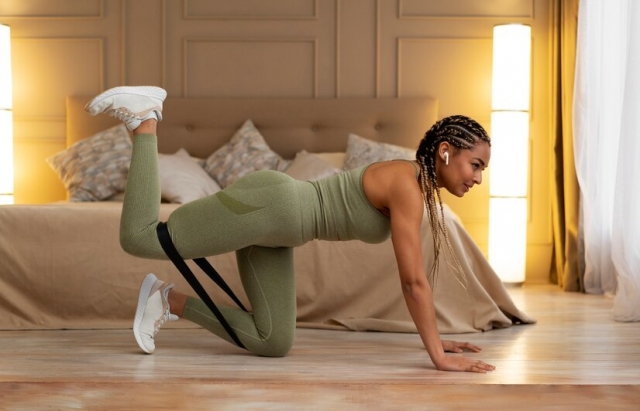Leg exercises form the foundation of a balanced fitness routine, pivotal in enhancing mobility, building strength, and supporting daily activities. Incorporating leg workouts into your home exercise regimen can yield multiple benefits, including stress management, testosterone production, strength building, and flexibility improvement. Here's a comprehensive guide to some of the best leg exercises you can do at home to meet various fitness goals.
The Importance of Leg Exercises
Leg muscles, which include the quadriceps, hamstrings, glutes, and calves, are among the largest in the body. Strengthening these muscles can significantly improve your ability to perform daily tasks, enhance athletic performance, and reduce the risk of injuries. Beyond these physical benefits, leg exercises contribute to overall well-being by:
1. Stress Management: Physical activity triggers the release of endorphins, the body's natural stress relievers. These chemicals help reduce anxiety and promote a sense of well-being. Regular exercise is linked to lower levels of stress and anxiety.
2. Testosterone Building: Compound leg exercises can stimulate testosterone production, a hormone essential for muscle growth and overall vitality, especially in men. Resistance training, particularly exercises involving large muscle groups like those in the legs, has been shown to boost testosterone levels.
3. Strength Building: Strong leg muscles provide a solid foundation for the entire body, facilitating everyday movements and enhancing overall physical strength.
4. Flexibility: Flexibility exercises improve the range of motion in your joints, which is crucial for preventing injuries and maintaining mobility as you age. Stretching and flexibility exercises, such as those targeting the leg muscles, are vital for maintaining and improving joint function.
Top Leg Exercises to Perform at Home
Here are some effective leg exercises you can perform at home to achieve your fitness goals, with or without special equipment.
1. Squats
Benefits: Squats are fundamental for building leg strength and muscle mass. They primarily target the quadriceps, hamstrings, and glutes while engaging the core for stability. Squats are highly effective for improving lower body strength and overall fitness.
How to Perform:
- Stand with your feet shoulder-width apart.
- Lower your body as if sitting back into a chair, keeping your back straight and knees in line with your toes.
- Lower until your thighs are parallel to the floor, then push through your heels to return to the starting position.
Variations: To increase difficulty or add variety, try goblet squats, jump squats, or single-leg squats.
2. Lunges
Benefits: Lunges are excellent for building leg strength and stability. They engage the quadriceps, hamstrings, glutes, and calves while improving balance and coordination. Lunges are versatile and effective for simultaneously targeting multiple leg muscles.
How to Perform:
- Stand upright with your feet hip-width apart.
- Step forward with one leg, lowering your hips until both knees are bent at about 90 degrees.
- Push back up to the starting position and repeat on the other side.
Variations: Add variety with walking lunges, reverse lunges, or lateral lunges.
3. Glute Bridges
Benefits: Glute bridges target the glutes and engage the hamstrings and lower back. They are effective for enhancing hip flexibility and strengthening the posterior chain, crucial for maintaining balance and reducing lower back pain.
How to Perform:
- Lie on your back with your knees bent and feet flat on the floor.
- Lift your hips towards the ceiling, squeezing your glutes at the top.
- Lower your hips back to the floor and repeat.
Variations: Increase intensity with single-leg glute bridges or add resistance bands.
4. Calf Raises
Benefits: Calf raises strengthen the calf muscles, improving lower leg strength and stability. Strong calves are essential for running, jumping, and balance [8].
How to Perform:
- Stand with your feet shoulder-width apart.
- Slowly raise your heels off the ground, balancing on your toes.
- Lower back down with control and repeat.
Variations: For a greater range of motion, perform calf raises on a step or try single-leg calf raises for added difficulty.
5. Bulgarian Split Squats
Benefits: This exercise targets the quadriceps and glutes while improving balance and coordination. It's particularly effective for unilateral strength training, helping to address muscle imbalances and enhance lower body strength.
How to Perform:
- Stand a few feet in front of a bench or chair and place one foot on the bench behind you.
- Lower your body into a squat, keeping your front knee aligned with your toes.
- Push through your front heel to return to the starting position and repeat on the other side.
Variations: Add weights for increased resistance or perform the exercise with your rear foot on a stability ball for an added balance challenge.
6. High Knees
Benefits: High knees are a dynamic exercise that improves cardiovascular endurance and strengthens the hip flexors, quads, and calves. They are also great for warming up the body and getting the heart rate up.
How to Perform:
- Stand with your feet hip-width apart.
- Lift your knees towards your chest rapidly, similar to running in place.
- Keep your core engaged and maintain a brisk pace.
Variations: Incorporate high knees into a high-intensity interval training (HIIT) routine for a cardiovascular boost.
7. Hamstring Curls
Benefits: Hamstring curls strengthen the hamstrings and glutes, crucial for bending and lifting activities. They effectively isolate and target the back of the legs.
How to Perform:
- Lie face down on a mat with your legs extended.
- Bend your knees, bringing your heels towards your glutes.
- Lower your feet back to the starting position and repeat.
Variations: Use a resistance band or stability ball to add resistance to the exercise.
Integrating Leg Exercises into Your Routine
To maximize the benefits of your leg workouts, consider the following tips:
1. Warm-Up and Cool-Down: Always start with a warm-up to prepare your muscles and end with a cool-down to promote recovery. This can prevent injuries and improve performance [12].
2. Combine Exercises: Incorporate a mix of strength, flexibility, and cardio exercises to target all aspects of leg fitness. This comprehensive approach ensures balanced development and functionality.
3. Progressive Overload: Gradually increase the intensity of your workouts by adding weights, increasing reps, or trying more challenging variations. Progressive overload is key to continual improvement and muscle growth.
4. Rest and Recovery: Allow your muscles to recover by taking rest days or focusing on different muscle groups on alternate days. Recovery is essential for muscle repair and growth.
Conclusion
Leg exercises are a vital component of any home workout routine. They build strength, improve flexibility, enhance balance, and help manage stress. By incorporating these exercises into your fitness regimen, you can achieve a well-rounded and effective workout, all from the comfort of your home.
For more leg exercises and detailed workout plans, visit Homeworkoutplanplan.com Leg Exercises at Homes.
References:
- American Council on Exercise, "Lunge Exercise," accessed June 17, 2024.
- "Leg Exercises at Home," Home Workout Plan, accessed June 17, 2024,
- Mayo Clinic, "Squat Exercise," accessed June 17, 2024.
- Harvard Health Publishing. "Exercising to Relax." Accessed June 17, 2024.






